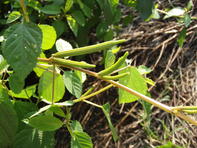Jew's mallow (Corchorus olitorius) is a nutritious leafy vegetable eaten in South Africa and falls under the collection of leafy vegetables know as morogo or imifino. It is believed to be first cultivated in ancient Egypt and is sometimes referred to as Egyptian spinach or molokhia in Arabic.

It also played a role in ancient Jewish culture hence the name ‘Jew's Mallow'. The plant is known in South Africa as wild jute, wilde jute (Afrikaans), thelele (Sepedi), delele (Tshivenda), gushe or bush okra and is widely found in arid regions of Africa and the Middle East.
Jew's mallow is found in the wild or near rural homesteads in the KwaZulu-Natal, Limpopo, Eastern Cape and Mpumalanga provinces of South Africa. Jew's mallow is an annual upright herb growing between 20 cm and 1.5 m tall, depending on the cultivar. The fresh leaves and fresh shoots are harvested for food.
The leaves are used for the treatment of bladder inflammation, gonorrhoea and painful urination. The rough stems are used as a source of jute for the making of textiles and paper while the light wood can be used to make matches. A study by the University of Fort Hare has shown that Jew's mallow leaves are superior in nutritional value compared to cabbage and spinach.
Eating Jew's Mallow
Jew's mallow leaves are very nutritious, high in protein 4.5%, rich in beta-carotene, iron, protein, calcium, B-vitamins, folate, vitamin C and E, and dietary fibre. Although Jew's mallow is often compared to spinach, its texture and flavour are different; more ‘earthy'.
Its taste is complemented by garlic and fresh lemon. Jew's mallow leaves are often boiled in chicken broth flavoured with garlic and dried coriander and then served on rice. Leaves can be eaten raw or cooked but become slimy when cooked, similar to okra.
When preparing coarse-textured leaves, such as those of cowpeas, adding Jew's mallow leaves makes it easier for older people to swallow. To reduce the sliminess bicarbonate of soda can be added to the boiling liquid.
Young leaves are added to salads. Dried leaves are used to thicken soups or can be ground to a flour for extended storage. Although best eaten fresh, the shelf life of Jew's mallow leaves can be extended by drying; fresh or cooked leaves are rolled into balls and sun-dried. The unripe fruits may be dried and ground into a powder to prepare a sauce.
How to Grow Jew's Mallow
Jew's mallow is best propagated from seed, planted 10 cm apart in rows, at a rate of 5-6 kg per hectare. Pre-soak seeds in warm water for 24 hours. It is best planted at the beginning of the rainy season. Jew’s mallow is very tolerant of soil conditions.
It prefers warm conditions and temperatures between 16℃ and 25℃ but is sensitive to drought and should not be planted in the shade. Irrigation is essential after sowing and transplanting. Research by the Agricultural Research Council (ARC) has seen that Jew’s mallow yield improves by fertilizer application, especially nitrogen.
Nitrogen is also reported to influence the nutritional value such as nitrogen (N), calcium (Ca) and phosphorus (P) content while adding calcium (Ca) and magnesium (Mg) to the soil can improve the development of fibre as well as yield and quality of Jew's mallow leaves.
The most common pests of Jew's mallow are spider mites, grasshoppers, caterpillars, army worms and flea beetles. Stem rot (Sclerotium rolfsii) can be managed by crop rotation and using raised beds. Leaves or tender shoots can be harvested from 30 - 60 days after planting (or before fruits ripen) depending on variety. Frequent harvesting (every two or three weeks) prolongs the season.